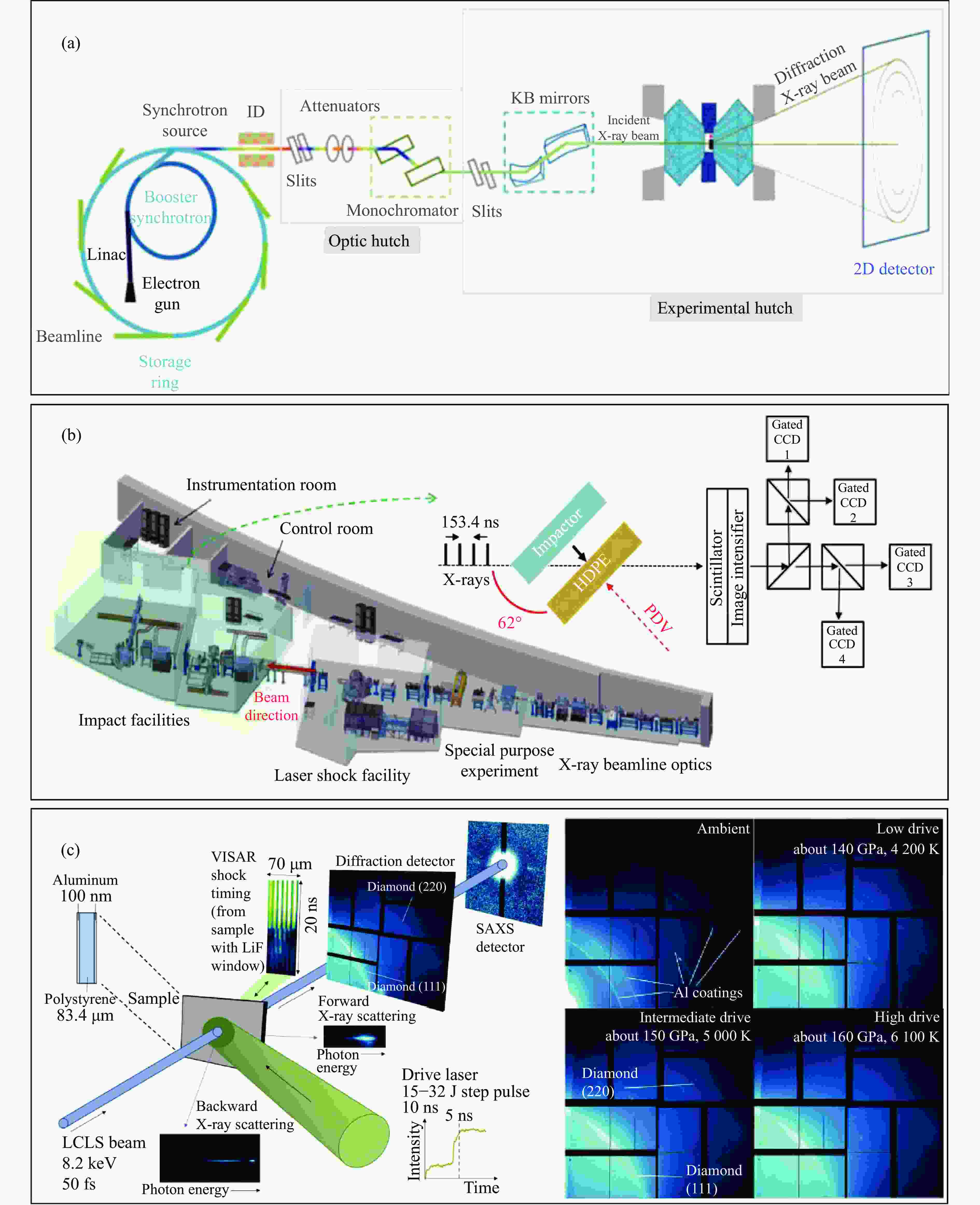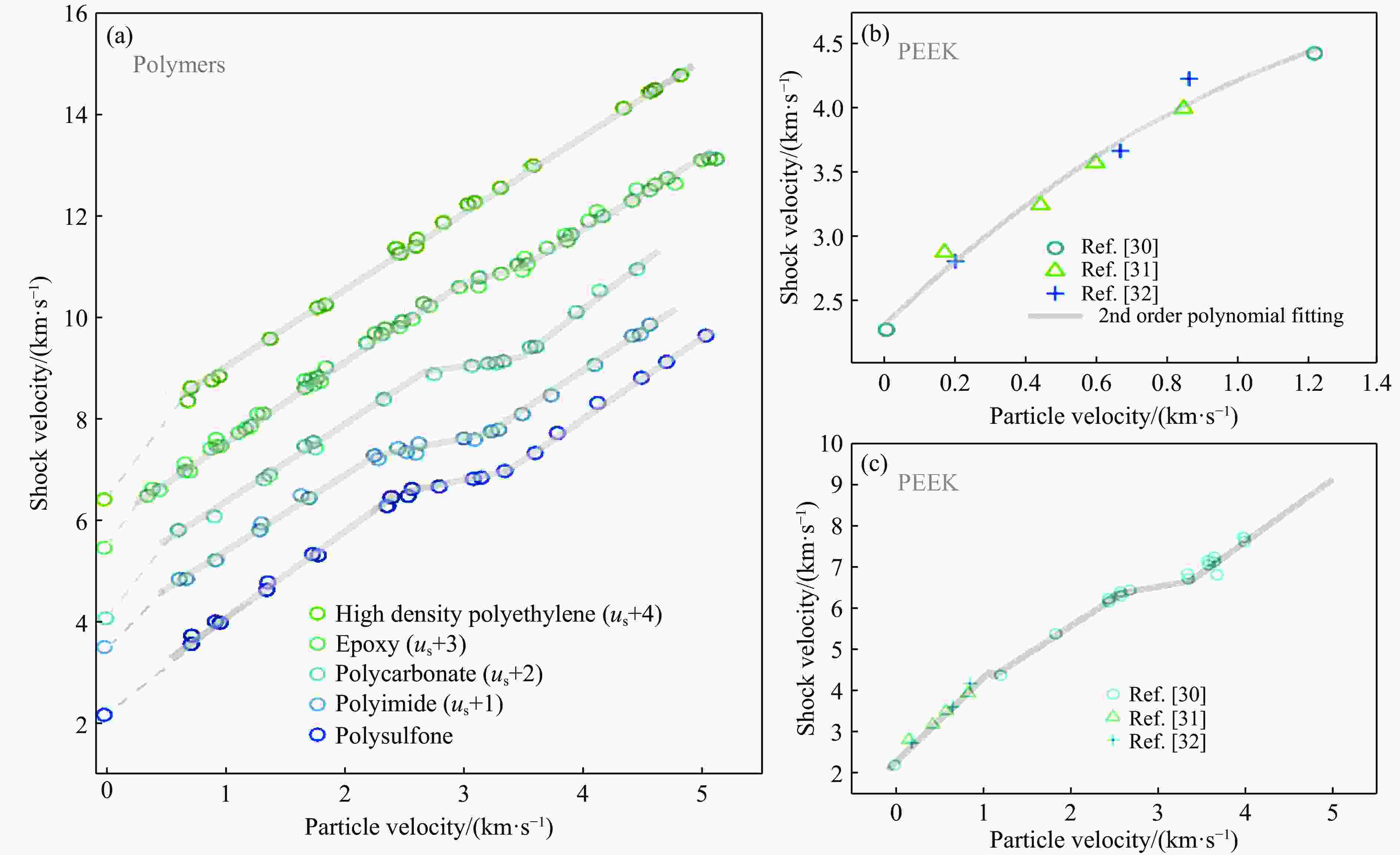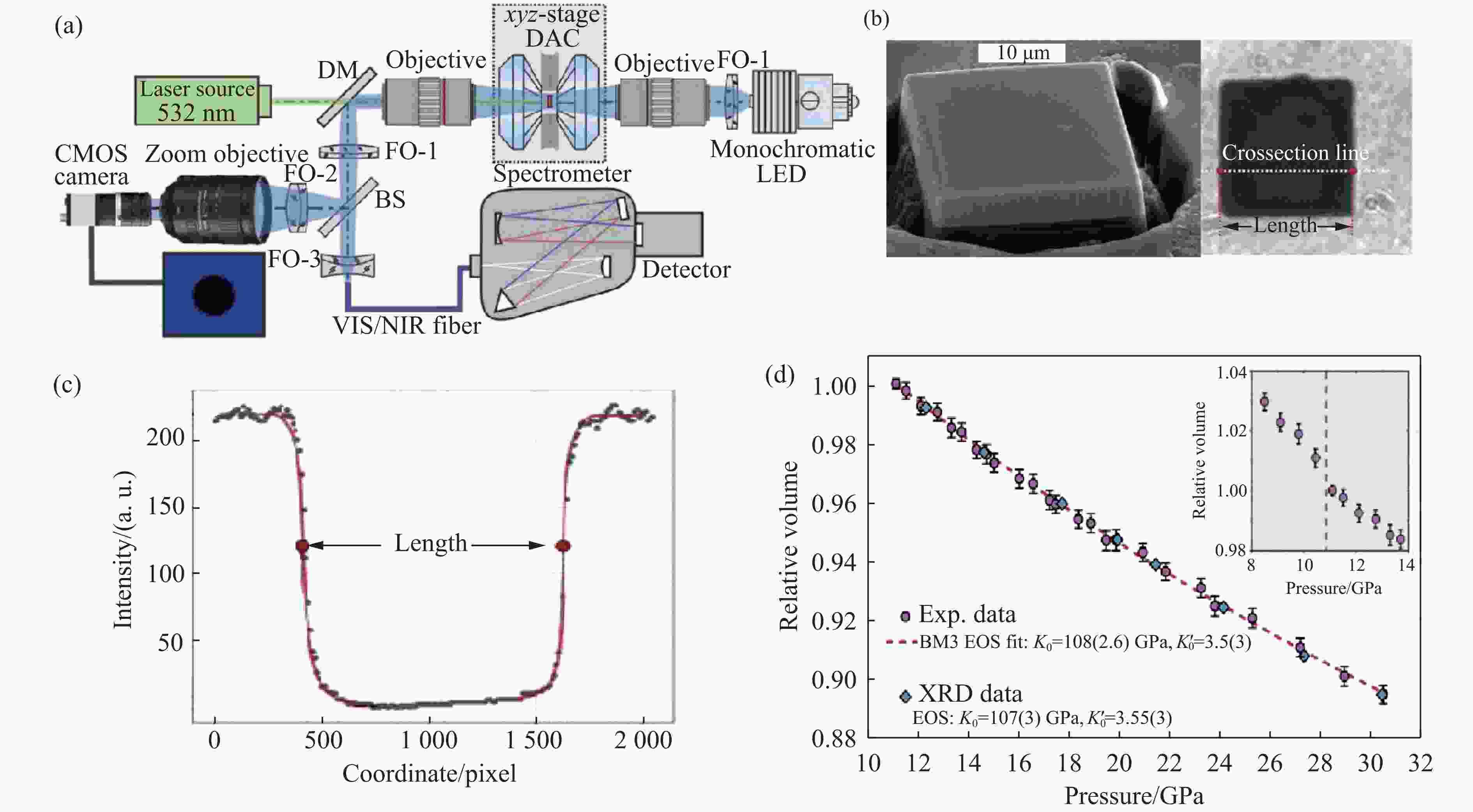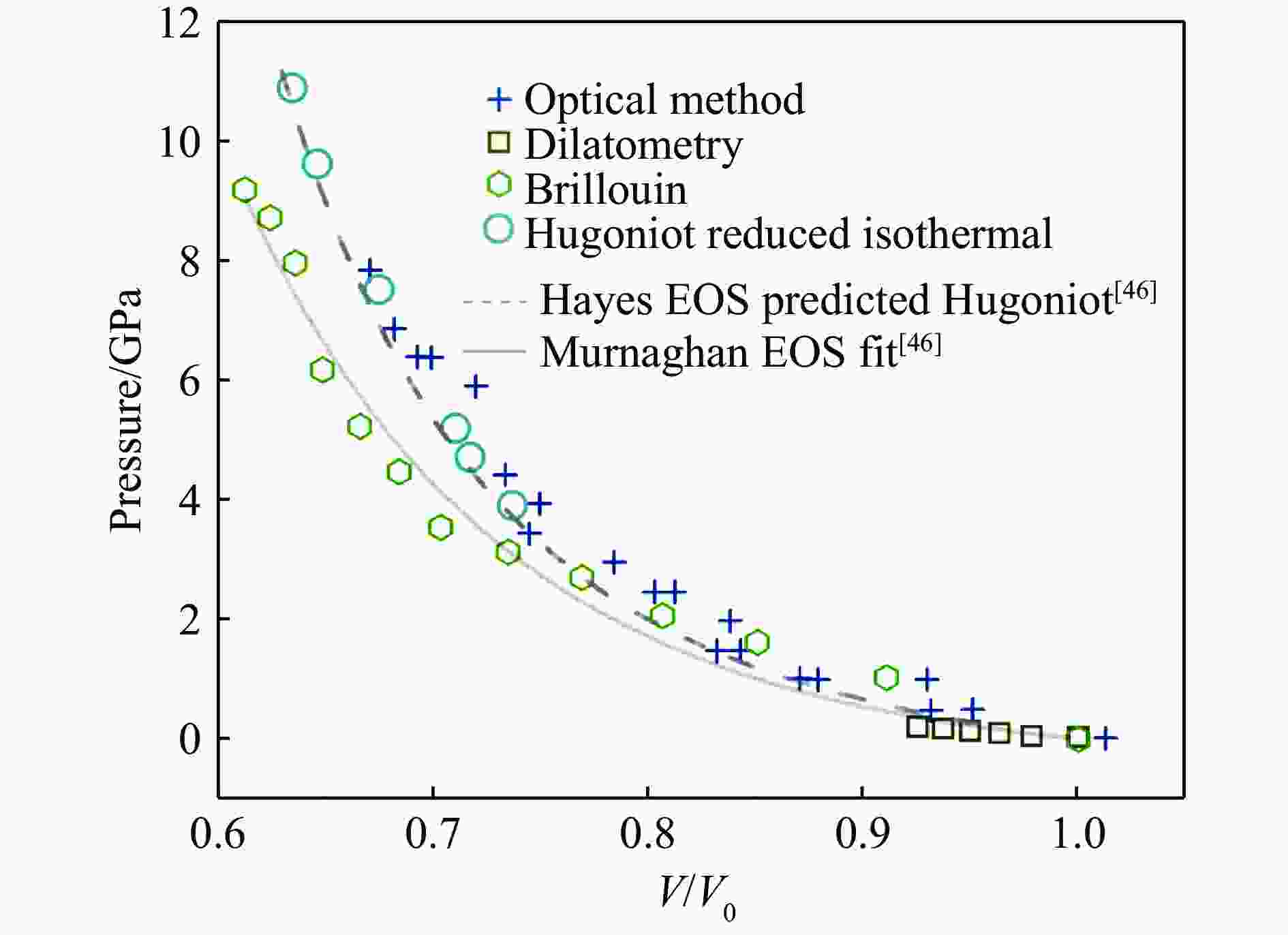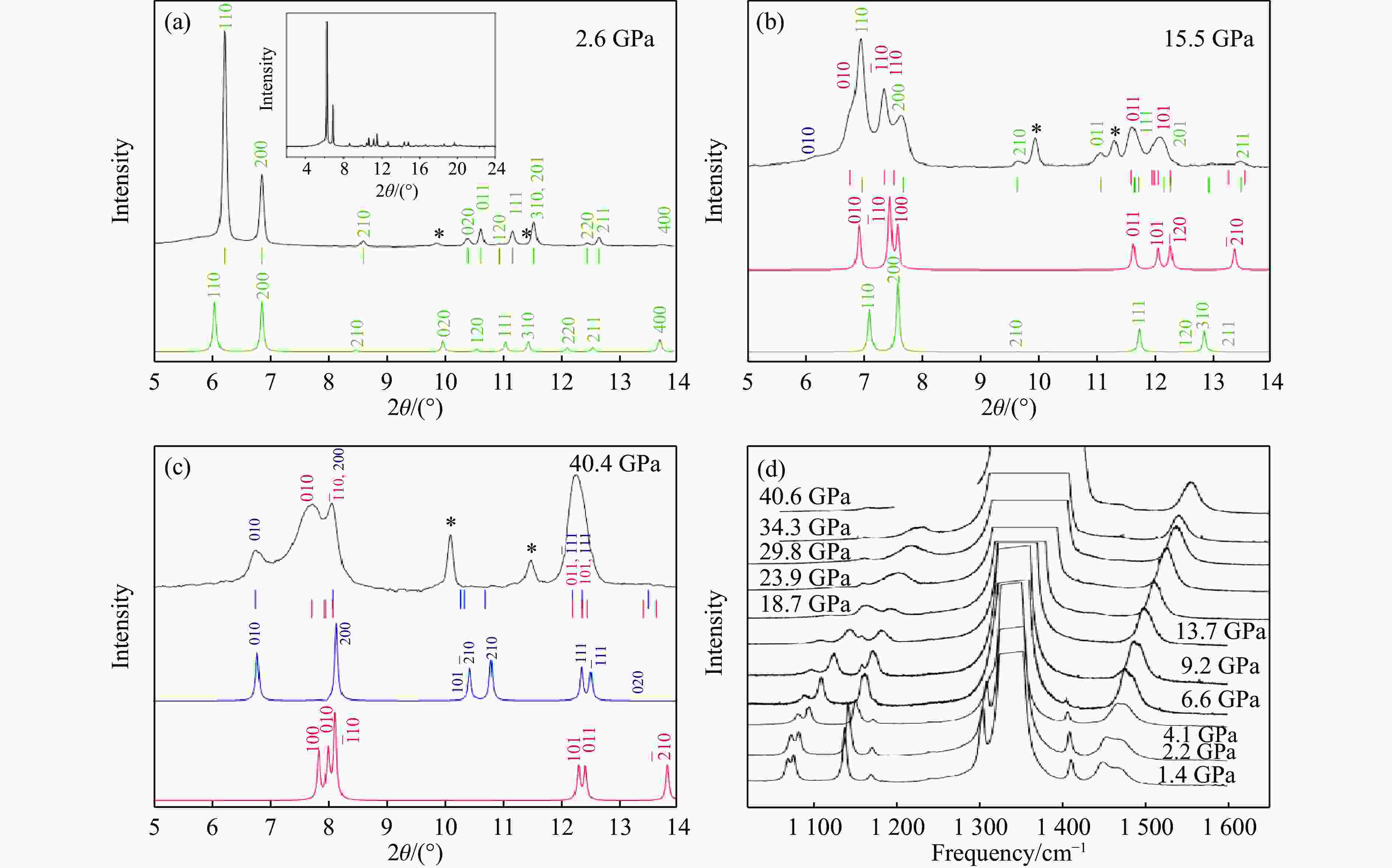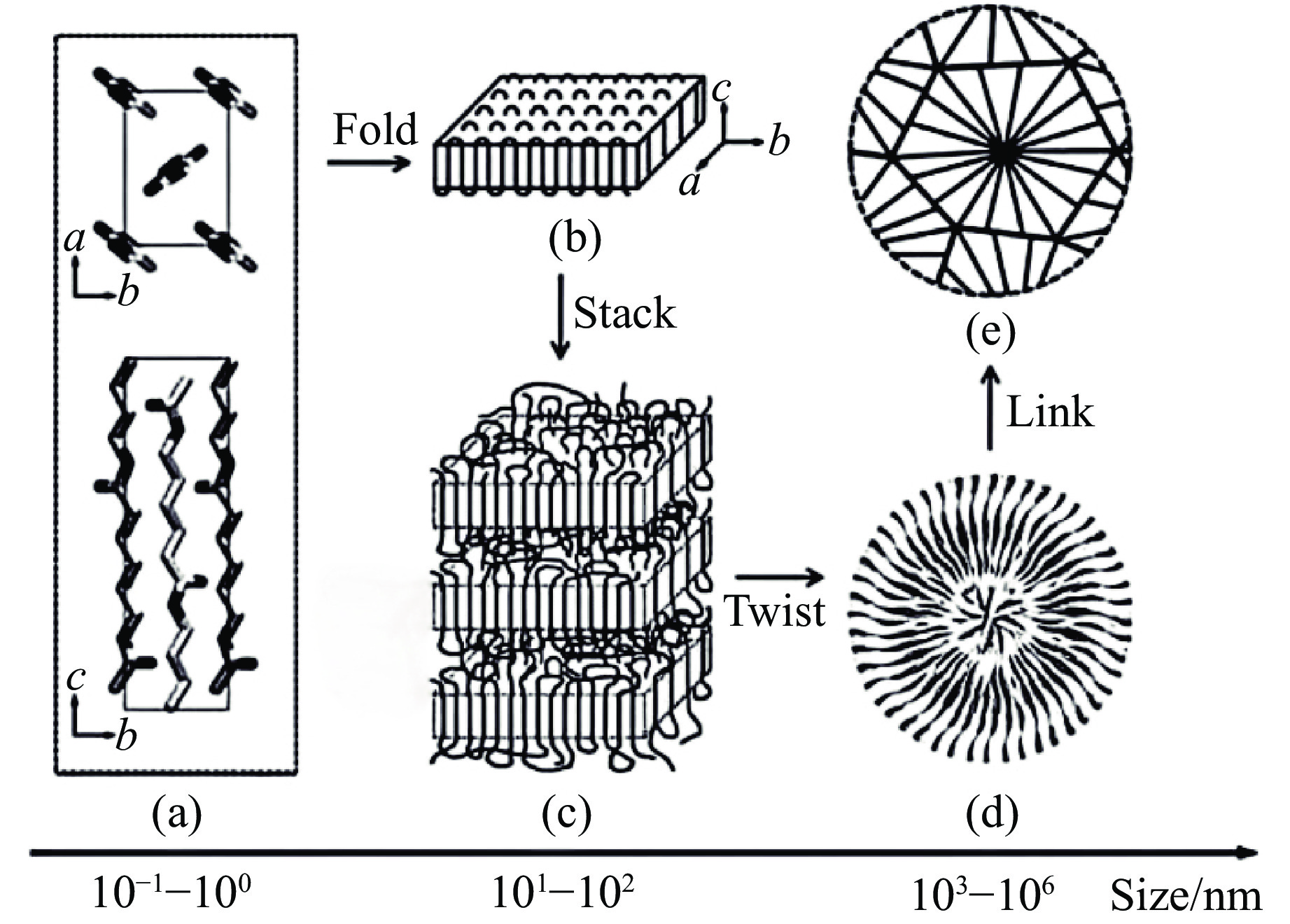Polymers at High Pressures and High Temperatures: Advances in Equation of State and Phase Transition Investigations
-
摘要: 聚合物是现代社会最实用的材料之一,也是含能材料领域的研究热点之一。随着应用范围的不断拓展,聚合物材料的服役环境日益极端。然而,到目前为止,人们对聚合物在高温高压极端条件下的状态方程和结构相变等重要物性还知之甚少,一定程度上限制了聚合物在更广阔领域的应用。聚合物自身的混合相态和多尺度分级结构给其在极端条件下的结构和物性研究带来了巨大的挑战。本文概述了近年来高温高压条件下聚合物状态方程和相变研究领域的进展,指出了目前聚合物状态方程和相变研究所面临的问题,以及现有实验技术的局限性,最后,从实验上提出了相关问题的潜在解决方法,希望对今后高温高压极端条件下聚合物状态方程和相变研究有所裨益。Abstract: Polymers are one of the most widely used materials in modern society. The interest of applying polymers under extreme conditions (high pressure and high temperature) is ever increasing. However, our knowledge of the equation of state (EOS) and phase transition of polymers at high pressures and high temperatures is extremely limited, which prevents their applications in broad fields. Because of their mixed phases and their hierarchical structures, investigation on the structures and properties of polymers at extreme conditions is a big challenge to date. In this short review, we summarize the recently published studies on the EOS and phase transition of polymers at extreme conditions. We point out the challenges faced and the limitations of the experimental techniques used, which is expected to be useful for the investigations of the EOS and phase transition of polymers in the future.
-
Key words:
- polymer /
- high pressure and high temperature /
- equation of state /
- phase transition
-
图 2 高温高压条件下聚合物的状态方程和结构研究采用的实验技术:(a) DAC加载的基于同步辐射光源的X射线衍射实验的实验系统[22],其中,ID为插入件(insertion device),包括扭摆器(wiggler)和波荡器(undulator),(b) 美国阿贡国家实验室APS光源的DCS实验站(该实验站建有基于轻气炮加载的同步辐射X射线衍射实验系统[29],其中,HDPE为高密度聚乙烯(high-density polyethylene),PDV(photon Doppler velocimetry)为光子多普勒测速),(c) 基于激光冲击加载和XFEL的聚合物结构测量实验光路(包括X射线广角衍射和小角散射等[16],其中,LCLS(Linac Coherent Light Source)是位于斯坦福的XFEL装置,VISAR为任意面反射激光干涉测速系统(velocity interferometer system for any reflector))
Figure 2. Experimental techniques for research of equation of state and phase transition of polymers at high pressures and high temperatures: (a) schematic of synchrotron-based X-ray diffraction beamline with diamond anvil cell, which generates high pressure and high temperature conditions[22], in which ID is insertion device, including wigglers and undulators; (b) synchrotron-based X-ray diffraction beamline combined with gas-gun driven compression at Dynamic Compression Sector of Advanced Photon Source, Argonne National Laboratory[29], in which HDPE is high-density polyethylene, and PDV is photon Doppler velocimetry; (c) structure determination of laser-shocked polymer using X-ray free electron laser, including X-ray wide-angle diffraction and small angle scattering techniques[16], in which LCLS is linac coherent light source
图 3 (a) 聚合物的Hugoniot状态方程[8],(b) PEEK的Hugoniot状态方程在低压段的数据,图中的实线是采用二次函数的拟合结果:us = c0+s1up+$s_2 u_{\mathrm{p}}^2 $,(c) PEEK的Hugoniot状态方程[30–32](图中的实线是一次函数拟合结果,us-up关系需分4段进行拟合)
Figure 3. (a) Hugoniot equation of states of polymers[8]; (b) Hugoniot equation of states of PEEK at low pressures (Solid line show the quadratic fitting result: us = c0+s1up+$s_2 u_{\mathrm{p}}^2 $); (c) Hugoniot equation of states of PEEK[30–32] (Solid lines show the linear fitting results, which are made up of four distinct lines in different regimes. )
图 4 (a) Kel-F800(chlorotrifluoroethylene-co-vinylidene fluoride)在0~18.5 GPa压力范围内的状态方程[39](Kel-F800在低压段的压缩趋势(绿色数据点)与高压段(蓝色数据点)明显不同,实线为采用三阶Birch-Murnaghan状态方程拟合整个压力范围内的数据的结果),(b) Kel-F800在高压下的典型布里渊散射谱
Figure 4. (a) Equation of state of Kel-F800 up to 18.5 GPa[39], which indicates the different compressive behaviors of Kel-F800 at low pressures (green points) and high pressures (blue points) (Solid line is the fitting result of all the experimental data points using 3rd order Birch-Murnaghan equation of state); (b) the typical Brillouin spectra of Kel-F800 at high pressures
图 5 Fedotenko等[45]发展改进的可见光成像状态方程测量方法:(a) 可见光成像状态方程测量系统(DM(dichroic mirror)为二色镜,FO (focusing optics)为聚焦光学器件,BS为50/50分光镜,CMOS是用于图像观察的相机,VIS(visible)表示可见光,NIR(near-infrared)表示近红外光),(b) 利用FIB聚焦离子束切割的规则形状的样品,(c) 样品尺寸的判读方法,(d) 可见光成像测量获得的金属Ti的状态方程与X射线衍射实验测量结果的对比,其中,${K_0} $和${{{K}}_0 '} $分别为体积模量及体积模量在环境压力下的压力导数
Figure 5. Optical equation of state measurement method developed by Fedotenko et al.[45]: (a) optical equation of state measurement system, in which DM is the long-pass dichroic mirror, FOs are the focusing optics, BS is the 50/50 beam splitter, and CMOS is the camera for image observation, VIS is visible light, NIR is near-infrared light; (b) the sample with sharp edges manufactured by focused ion beam technique; (c) linear size measurement; (d) comparison of the equation of states of metallic Ti measured by the optical method and X-ray diffraction technique, in which ${K_0} $ and ${{{K}}_0 '} $ are the bulk modulus and its pressure derivative at ambient pressure, respectively
图 6 不同方法测量的VCE的状态方程[46](即使在12 GPa较低的压力范围内,不同方法测量的VCE的状态方程表现出很大的差异,实验数据的分散性很大)
Figure 6. Equation of states of VCE measured by different techniques[46] (The results measured by different techniques present large discrepancy even in the very low pressure condition of 12 GPa. Furthermore, the experimental data pointes are quite scattered.)
图 7 (a)~(c)不同压力下PE的典型衍射谱[47](绿色为理论模拟的正交的Pnma结构的衍射谱,红色为单斜的P21/m结构的衍射谱,蓝色为单斜的A2/m结构的衍射谱),(d)不同压力下PE的拉曼谱[48](
1340 cm−1附近的强峰是金刚石的拉曼峰)Figure 7. (a)–(c) Typical X-ray diffraction spectra of PE at high pressures[47] (The green, red and blue spectra are the ab initio simulated patterns of the orthorhombic Pnma, monoclinic P21/m, and the monoclinic A2/m structures, respectively.); (d) Raman spectra of PE at selected pressures[48] (The broad and strong peak at about
1340 cm−1 is the Raman peak from diamond anvils.)表 1 聚合物状态方程的测量方法比较
Table 1. Comparison of different techniques for equation of state measurement of polymers
Measurement method Measurement information Pressure range/GPa Potential issues Shock Hugoniot Compressibility of bulk materials > 1000 Temperature effect: if the shock temperature is higher than Tg, then the measured properties are those of the glassy polymer.
Strain rate dependency.Brillouin scattering Compressibility of bulk materials about 1–85 Pressure limitations: for materials with a low Tg, vT can’t be measured at low pressure (1 GPa), and at high pressure (85 GPa), the Brillouin signal of the diamond obscures the vL signal of the polymer, which limit the pressure range for sound velocity measurements.
Frequency effect: the frequency of Brillouin scattering experiments is 109 Hz, which results in an overestimation of the first derivative of the bulk modulus of the polymer with respect to pressure.
Numerical errors introduced by γVisible light imaging Compressibility of bulk materials >80 Small molecules of the pressure-transmitting medium enter the
“free volume” of the polymer.
Non-hydrostatic conditions at high pressures lead to the failure of the isotropy assumption.
Low accuracyDilatometor Compressibility of bulk materials about 0.2 Pressure range too small X-ray diffraction Compressibility of crystalline phases >200 Only reflects the information of the crystalline part, lacking of the information about amorphous parts, and not reflecting the compressibility of bulk materials -
[1] MISHRA M. Encyclopedia of polymer applications: 3 volume set [M]. Boca Raton: CRC Press, 2019. [2] COLCLOUGH M E, DESAI H, MILLAR R W, et al. Energetic polymers as binders in composite propellants and explosives [J]. Polymers for Advanced Technologies, 1994, 5(9): 554–560. doi: 10.1002/pat.1994.220050914 [3] XIAO Y C, XIAO X D, XIONG Y Y, et al. Mechanical behavior of a typical polymer bonded explosive under compressive loads [J]. Journal of Energetic Materials, 2023, 41(3): 378–410. doi: 10.1080/07370652.2021.1980151 [4] WOODS H, BODDORFF A, EWALDZ E, et al. Rheological considerations for binder development in direct ink writing of energetic materials [J]. Propellants, Explosives, Pyrotechnics, 2020, 45(1): 26–35. doi: 10.1002/prep.201900159 [5] HUANG B B, XUE Z H, FU X L, et al. Advanced crystalline energetic materials modified by coating/intercalation techniques [J]. Chemical Engineering Journal, 2021, 417: 128044. doi: 10.1016/j.cej.2020.128044 [6] AGRAWAL J P, DODKE V S. Some novel high energy materials for improved performance [J]. Zeitschrift für Anorganische und Allgemeine Chemie, 2021, 647(19): 1856–1882. [7] ABBOTT A, BRANCH B, BROWN E N, et al. The dynamic response of polymers interrogated by 3rd generation X-ray light source: LA-UR-19-29436 [R]. Los Alamos: Los Alamos National Laboratory, 2019. [8] CARTER W J, MARSH S P. Hugoniot equation of state of polymers: LA-13006-MS [R]. Los Alamos: Los Alamos National Laboratory, 1995. [9] COE J D, BROWN E, CADY C M, et al. Equation of state and damage in polyethylene: LA-UR-17-29234 [R]. Los Alamos: Los Alamos National Laboratory, 2019. [10] DATTELBAUM D M, SHEFFIELD S, MCGRANE S D, et al. First reactions: understanding chemistry behind the shock front: LA-UR-12-25050 [R]. Los Alamos: Los Alamos National Laboratory, 2012. [11] 国家自然科学基金委员会, 中国科学院. 中国学科发展战略(上): 软凝聚态物理学 [M]. 北京: 科学出版社, 2020. [12] BRIDGMAN P W. Linear compressions to 30 000 kg/cm2, including relatively incompressible substances [J]. Proceedings of the American Academy of Arts and Sciences, 1949, 77(6): 189–234. doi: 10.2307/20023541 [13] WUNDERLICH B, ARAKAWA T. Polyethylene crystallized from the melt under elevated pressure [J]. Journal of Polymer Science: Part A: General Papers, 1964, 2(8): 3697–3706. doi: 10.1002/pol.1964.100020828 [14] WARD I M. Mechanical properties of solid polymers [M]. 2nd ed. New York: John Wiley, 1983: 135-166. [15] KRAUS D, VORBERGER J, PAK A, et al. Formation of diamonds in laser-compressed hydrocarbons at planetary interior conditions [J]. Nature Astronomy, 2017, 1(9): 606–611. doi: 10.1038/s41550-017-0219-9 [16] KRAUS D, HARTLEY N J, FRYDRYCH S, et al. High-pressure chemistry of hydrocarbons relevant to planetary interiors and inertial confinement fusion [J]. Physics of Plasmas, 2018, 25(5): 056313. doi: 10.1063/1.5017908 [17] HE Z Y, RÖDEL M, LÜTGERT J, et al. Diamond formation kinetics in shock-compressed C-H-O samples recorded by small-angle X-ray scattering and X-ray diffraction [J]. Science Advances, 2022, 8(35): eabo0617. doi: 10.1126/sciadv.abo0617 [18] 朱诚身. 聚合物结构分析 [M]. 2版. 北京: 科学出版社, 2010. [19] GUO Q P. Polymer morphology: principles, characterization, and processing [M]. Hoboken: John Wiley & Son, 2016. [20] ALS-NIELSEN J, MCMORROW D. Elements of modern X-ray physics [M]. 2nd ed. Chichester: John Wiley & Sons, 2011. [21] KAO C C. Challenges and opportunities for the next decade of XFELs [J]. Nature Reviews Physics, 2020, 2(7): 340–341. doi: 10.1038/s42254-020-0196-2 [22] LIU L. Synthesis and tuning of multifunctional materials at high pressure [D]. Uppsala: Acta Universitatis Upsaliensis, 2020. [23] DREWITT J W E. Liquid structure under extreme conditions: high-pressure X-ray diffraction studies [J]. Journal of Physics: Condensed Matter, 2021, 33(50): 503004. doi: 10.1088/1361-648X/ac2865 [24] DUBROVINSKY L, KHANDARKHAEVA S, FEDOTENKO T, et al. Materials synthesis at terapascal static pressures [J]. Nature, 2022, 605(7909): 274–278. doi: 10.1038/s41586-022-04550-2 [25] TATENO S, HIROSE K, OHISHI Y, et al. The structure of iron in Earth's inner core [J]. Science, 2010, 330(6002): 359–361. doi: 10.1126/science.1194662 [26] SHEN G Y, MAO H K. High-pressure studies with X-rays using diamond anvil cells [J]. Reports on Progress in Physics, 2017, 80(1): 016101. doi: 10.1088/1361-6633/80/1/016101 [27] SINCLAIR N W, TURNEAURE S J, WANG Y, et al. The fast multi-frame X-ray diffraction detector at the dynamic compression sector [J]. Journal of Synchrotron Radiation, 2021, 28(4): 1216–1228. doi: 10.1107/S1600577521003775 [28] BROEGE D, FOCHS S, BRENT G, et al. The dynamic compression sector laser: a 100-J UV laser for dynamic compression research [J]. Review of Scientific Instruments, 2019, 90(5): 053001. doi: 10.1063/1.5088049 [29] HUBER R C, WATKINS E B, DATTELBAUM D M, et al. In situ X-ray diffraction of high density polyethylene during dynamic drive: polymer chain compression and decomposition [J]. Journal of Applied Physics, 2021, 130(17): 175901. doi: 10.1063/5.0057439 [30] BOETTGER J C, JOHNSON J D. SESAME equation of state number 8020: polyetheretherketone (PEEK): LA-12684-MS [R]. Los Alamos: Los Alamos National Laboratory, 1993. [31] MILLETT J C F, BOURNE N K, GRAY III G T. The response of polyether ether ketone to one-dimensional shock loading [J]. Journal of Physics D: Applied Physics, 2004, 37(6): 942–947. doi: 10.1088/0022-3727/37/6/021 [32] ROBERTS A, APPLEBY-THOMAS G J, HAZELL P. Experimental determination of Grüneisen gamma for polyether ether ketone (PEEK) using the shock-reverberation technique [J]. AIP Conference Proceeding, 2012, 1426(1): 824–827. [33] MAERZKE K A, COE J D, TICKNOR C, et al. Equations of state for polyethylene and its shock-driven decomposition products [J]. Journal of Applied Physics, 2019, 126(4): 045902. doi: 10.1063/1.5099371 [34] HUBER R C, PETERSON J, COE J D, et al. Polysulfone shock compressed above the decomposition threshold: velocimetry and modeling of two-wave structures [J]. Journal of Applied Physics, 2020, 127(10): 105902. doi: 10.1063/1.5124252 [35] BARRIOS M A, HICKS D G, BOEHLY T R, et al. High-precision measurements of the equation of state of hydrocarbons at 1–10 Mbar using laser-driven shock waves [J]. Physics of Plasmas, 2010, 17(5): 056307. doi: 10.1063/1.3358144 [36] LÜTGERT J, VORBERGER J, HARTLEY N J, et al. Measuring the structure and equation of state of polyethylene terephthalate at megabar pressures [J]. Scientific Reports, 2021, 11(1): 12883. doi: 10.1038/s41598-021-91769-0 [37] ROOT S, MATTSSON T R, COCHRANE K, et al. Shock compression response of poly(4-methyl-1-pentene) plastic to 985 GPa [J]. Journal of Applied Physics, 2015, 118(20): 205901. doi: 10.1063/1.4936168 [38] STEVENS L L, ORLER E B, DATTELBAUM D M, et al. Brillouin-scattering determination of the acoustic properties and their pressure dependence for three polymeric elastomers [J]. The Journal of Chemical Physics, 2007, 127(10): 104906. doi: 10.1063/1.2757173 [39] STEVENS L L, DATTELBAUM D M, AHART M, et al. High-pressure elastic properties of a fluorinated copolymer: poly(chlorotrifluoroethylene-co-vinylidene fluoride) (Kel-F800) [J]. Journal of Applied Physics, 2012, 112(2): 023523. doi: 10.1063/1.4737590 [40] BENJAMIN A S, AHART M, GRAMSCH S A, et al. Acoustic properties of Kel F-800 copolymer up to 85 GPa [J]. The Journal of Chemical Physics, 2012, 137(1): 014514. doi: 10.1063/1.4731706 [41] ZHA C S, MAO H K, HEMLEY R J. Elasticity of MgO and a primary pressure scale to 55 GPa [J]. Proceedings of the National Academy of Sciences of the United States of America, 2000, 97(25): 13494–13499. [42] DATTELBAUM D M, JENSEN J D, SCHWENDT A M, et al. A novel method for static equation-of state-development: equation of state of a cross-linked poly(dimethylsiloxane) (PDMS) network to 10 GPa [J]. The Journal of Chemical Physics, 2005, 122(14): 144903. doi: 10.1063/1.1879872 [43] SHEN G Y, MEI Q, PRAKAPENKA V B, et al. Effect of helium on structure and compression behavior of SiO2 glass [J]. Proceedings of the National Academy of Sciences of the United States of America, 2011, 108(15): 6004–6007. [44] ZENG Z D, WEN J G, LOU H B, et al. Preservation of high-pressure volatiles in nanostructured diamond capsules [J]. Nature, 2022, 608(7923): 513–517. doi: 10.1038/s41586-022-04955-z [45] FEDOTENKO T, SOUZA D S, KHANDARKHAEVA S, et al. Isothermal equation of state of crystalline and glassy materials from optical measurements in diamond anvil cells [J]. Review of Scientific Instruments, 2021, 92(6): 063907. doi: 10.1063/5.0050190 [46] DATTELBAUM D M, STEVENS L L. Equations of state of binders and related polymers [M]//PEIRIS S M, PIERMARINI G J. Static Compression of Energetic Materials. Berlin Heidelberg: Springer, 2008: 127–202. [47] FONTANA L, VINH D Q, SANTORO M, et al. High-pressure crystalline polyethylene studied by X-ray diffraction and ab initio simulations [J]. Physical Review B, 2007, 75(17): 174112. doi: 10.1103/PhysRevB.75.174112 [48] FONTANA L, SANTORO M, BINI R, et al. High-pressure vibrational properties of polyethylene [J]. The Journal of Chemical Physics, 2010, 133(20): 204502. doi: 10.1063/1.3507251 [49] CAPATINA D, D’AMICO K, NUDELL J, et al. DCS—a high flux beamline for time resolved dynamic compression science—design highlights [J]. AIP Conference Proceedings, 2016, 1741(1): 030036. [50] ROSS M. The ice layer in Uranus and Neptune-diamonds in the sky? [J]. Nature, 1981, 292(5822): 435–436. doi: 10.1038/292435a0 [51] HARTLEY N J, BROWN S, COWAN T E, et al. Evidence for crystalline structure in dynamically-compressed polyethylene up to 200 GPa [J]. Scientific Reports, 2019, 9(1): 4196. doi: 10.1038/s41598-019-40782-5 [52] FULLER W, OATES C R, GREENALL R J, et al. X-ray and neutron diffraction studies of the structure of PEEK [J]. Conference Series-Institute of Physics, 1990: 213−224. [53] WU W, WIGNALL G D, MANDELKERN L. A SANS study of the plastic deformation mechanism in polyethylene [J]. Polymer, 1992, 33(19): 4137–4140. doi: 10.1016/0032-3861(92)90617-6 [54] RAI D K, GILLILAN R E, HUANG Q Q, et al. High-pressure small-angle X-ray scattering cell for biological solutions and soft materials [J]. Journal of Applied Crystallography, 2021, 54(1): 111–122. doi: 10.1107/S1600576720014752 [55] GEORGIEV G, DAI P S, OYEBODE E, et al. Real-time small angle X-ray scattering study of two-stage melt crystallization of PEEK [J]. Journal of Materials Science, 2001, 36(6): 1349–1361. doi: 10.1023/A:1017595201893 [56] 杨科, 蒋升, 闫帅, 等. 上海同步辐射光源高压相关线站概述 [J]. 高压物理学报, 2020, 34(5): 050102. doi: 10.11858/gywlxb.20200584YANG K, JIANG S, YAN S, et al. Application of shanghai synchrotron radiation source in high pressure research [J]. Chinese Journal of High Pressure Physics, 2020, 34(5): 050102. doi: 10.11858/gywlxb.20200584 [57] 程贺, 张玮, 王芳卫, 等. 中国散裂中子源的多学科应用 [J]. 物理, 2019, 48(11): 701–707. doi: 10.7693/wl20191101CHENG H, ZHANG W, WANG F W, et al. Applications of the China spallation neutron source [J]. Physics, 2019, 48(11): 701–707. doi: 10.7693/wl20191101 [58] 李晓东, 袁清习, 徐伟, 等. 第四代高能同步辐射光源HEPS及高压相关线站建设 [J]. 高压物理学报, 2020, 34(5): 050101. doi: 10.11858/gywlxb.20200554LI X D, YUAN Q X, XU W, et al. Introduction of fourth-generation high energy photon source HEPS and the beamlines for high-pressure research [J]. Chinese Journal of High Pressure Physics, 2020, 34(5): 050101. doi: 10.11858/gywlxb.20200554 [59] 王洪翠, 张波, 谷鸣. SHINE装置的准直器设计 [J]. 真空电子技术, 2022(1): 32–35, 47.WANG H C, ZHANG B, GU M. Design of collimators for SHINE facility [J]. Vacuum Electronics, 2022(1): 32–35, 47. -






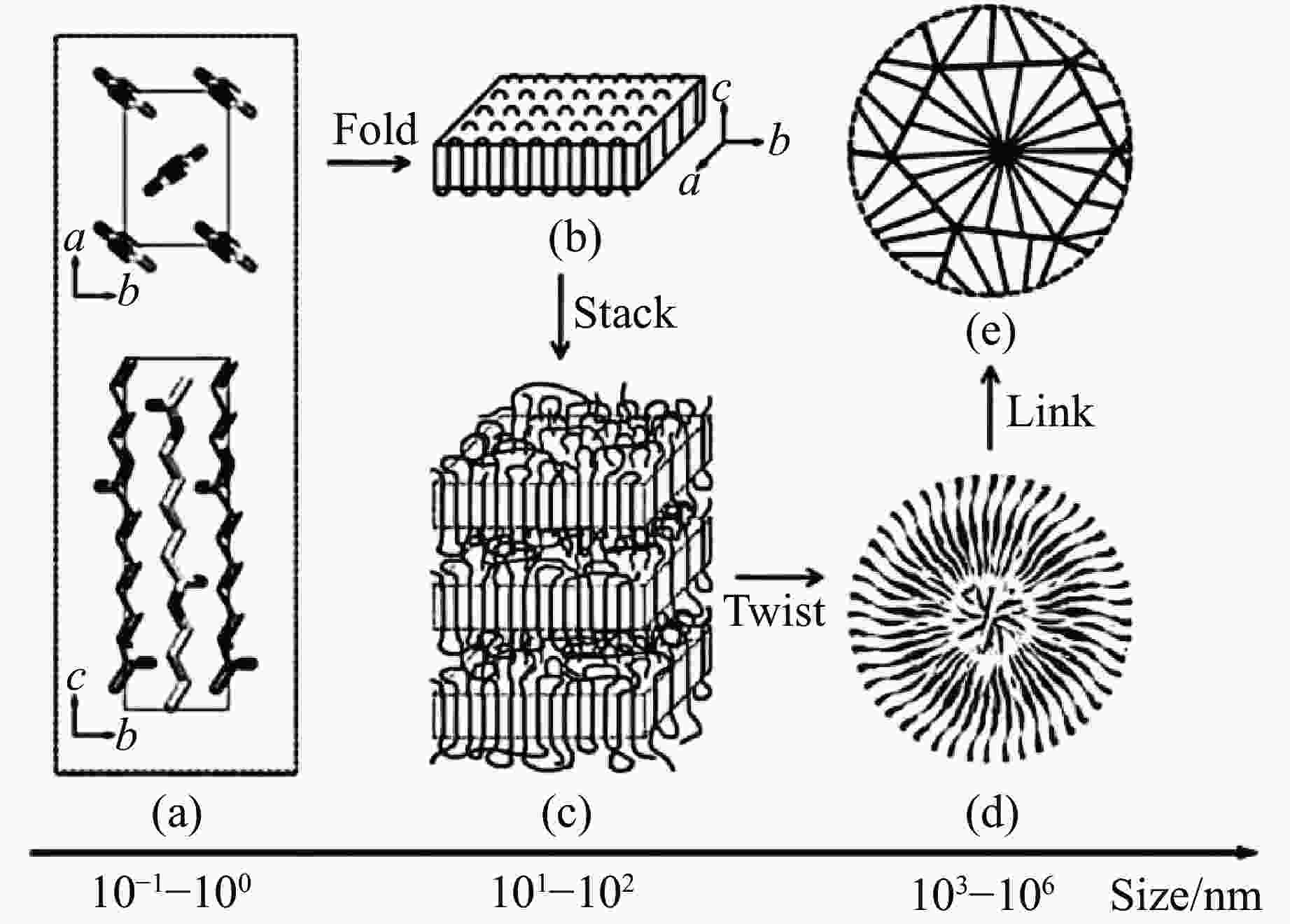
 下载:
下载:
